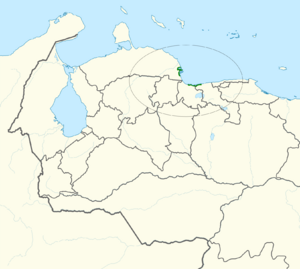Plain-flanked rail facts for kids
Quick facts for kids Plain-flanked rail |
|
|---|---|
| Conservation status | |
| Scientific classification | |
| Genus: |
Rallus
|
| Species: |
wetmorei
|
 |
|
The plain-flanked rail (Rallus wetmorei) is a special kind of bird. It belongs to the rail family, which also includes gallinules and coots. This bird is found only in Venezuela. Sadly, it is an Endangered species, meaning there are very few left in the world.
Contents
About the Plain-Flanked Rail
A Unique Bird Species
Scientists once thought the plain-flanked rail might be the same species as the mangrove rail. However, this idea is not widely accepted. Even when these two birds live near each other, they do not breed together. This shows that the plain-flanked rail is a unique species all on its own.
What Does It Look Like?
The plain-flanked rail is about 33 centimeters (13 inches) long. It has a brown beak. Male and female plain-flanked rails look very similar.
Their upper feathers are a dull gray-brown. The centers of these feathers are a bit darker. They have a white stripe near their eyes, on their gray-brown face. Their throat is whitish, and their belly is brown without any stripes.
Where Does It Live?
The plain-flanked rail is only found in a few places. These spots are along the Caribbean coast of Venezuela. You can find them between the eastern part of Falcón state and the western part of Aragua state.
This bird mostly lives in coastal mangrove forests. It has also been seen in the plants growing in salty or brackish water lagoons and marshes.
Behavior and Habits
Movement
The plain-flanked rail seems to stay in one place. It does not appear to travel far from its home area.
What Does It Eat?
We don't know much about what the plain-flanked rail eats or how it finds food. Scientists believe its diet and feeding habits are similar to those of the mangrove rail. This is because they live in similar places.
The mangrove rail eats many different things. Its diet includes animals like crabs, crayfish, snails, leeches, and insects. It also eats fish and amphibians. Sometimes, it eats plants too, such as seeds, berries, and plant roots.
Reproduction and Nests
The plain-flanked rail's breeding season is not fully known. However, we know they breed in April and May. A few nests have been found. These nests are platforms made of twigs and leaves. They are usually placed on mangrove roots or in mangrove trees.
Female plain-flanked rails lay between four and seven eggs. Both the male and female birds help to incubate (sit on) the eggs. The exact time it takes for the eggs to hatch or for the young birds to leave the nest is not yet known.
How Does It Communicate?
The plain-flanked rail has a special "advertising call." This call is a series of loud, fast "kek-kek-kek" notes. These calls are often given by a pair of birds together. Before these loud calls, they make soft growling "grrrrr" sounds.
Male birds that are trying to attract a mate make a series of harsh "kek" notes. These notes are spaced evenly apart. The plain-flanked rail also makes a grunting sound.
Status and Conservation
The IUCN (International Union for Conservation of Nature) first listed the plain-flanked rail as "Threatened" in 1988. Since 1994, it has been classified as "Endangered."
This bird lives in a very small area. Scientists estimate there are only about 50 to 200 adult plain-flanked rails left. This number is believed to be getting smaller. Their mangrove homes are being destroyed by new buildings for tourism. What's left of their habitat is also threatened by pollution from homes and factories. Protecting their homes is very important for their survival.


